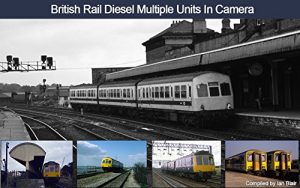A selection of British Rail first and second generation diesel multiple units in pictures.
By the time the Modernisation Plan was published in 1955 the railways were beginning to look a little run down as there was a huge backlog of maintenance that had built up since the start of the second world war and railway stations and rolling stock had become grimy, dirty smelly things that were no longer pleasant to travel in.
Very few new steam locomotives had been built since the end of the war, but fortunately three years previously in 1952 it had been suggested to the British Railways board that lightweight diesel multiple units could replace the aging steam locomotives and hauled coaches on as many as 168 routes.
The initial batch were built at the British Rail Derby works and because of their construction using light alloy and steel these were known as the Derby Lightweights and they were initially introduced on services between Leeds and Bradford to replace the aging 0-6-0 locomotives and ancient non-corridor coaches that made up the existing services, as could be expect passenger reactions to the new trains were very favourable.
The Modernisation Plan included a follow up with 4600 new diesel railcars but the British Rail works at Derby and Swindon didn’t have the capacity to handle orders of this size so the orders were passed to private carriage works such as the Birmingham Railway Carriage and Wagon Company, Cravens, Gloucester Railway Carriage and Wagon Company and Metro-Cammell.
This is one of the reasons for the variation in the appearance of all the first generation multiple units as they were designed by the companies that built them. They were all built to a basic set of conditions although many were built for slightly different uses, such as express trains, local trains and cross country services.
The new multiple units began to appear in the late 1950s and they quickly won over a lot of the travelling public with their relative comfort and cleanliness compared to the dirty steam trains and often old outdated carriages especially on some branch lines that had gone before. Their introduction especially on many of the smaller lines probably saved many services by the time Dr Beeching released his report in 1963 that would completely change the shape of Britains railway map by removing 5000 miles of mostly rural railways and halting the building of new rolling stock.
During the modernisation plan British Rail tried to replace like for like and replace the existing steam engines and coaches with new diesel locomotives and rolling stock but unfortunately the plan wasn’t thought through properly so a large number of different types were ordered many of which were built in small numbers and these were quickly pressed into service before all the bugs that are present in almost any new product were completely ironed out although some of them turned out to be successful and indeed more than one type lasted into the early 2000s.
By the time the Modernisation Plan was published in 1955 the railways were beginning to look a little run down as there was a huge backlog of maintenance that had built up since the start of the second world war and railway stations and rolling stock had become grimy, dirty smelly things that were no longer pleasant to travel in.
Very few new steam locomotives had been built since the end of the war, but fortunately three years previously in 1952 it had been suggested to the British Railways board that lightweight diesel multiple units could replace the aging steam locomotives and hauled coaches on as many as 168 routes.
The initial batch were built at the British Rail Derby works and because of their construction using light alloy and steel these were known as the Derby Lightweights and they were initially introduced on services between Leeds and Bradford to replace the aging 0-6-0 locomotives and ancient non-corridor coaches that made up the existing services, as could be expect passenger reactions to the new trains were very favourable.
The Modernisation Plan included a follow up with 4600 new diesel railcars but the British Rail works at Derby and Swindon didn’t have the capacity to handle orders of this size so the orders were passed to private carriage works such as the Birmingham Railway Carriage and Wagon Company, Cravens, Gloucester Railway Carriage and Wagon Company and Metro-Cammell.
This is one of the reasons for the variation in the appearance of all the first generation multiple units as they were designed by the companies that built them. They were all built to a basic set of conditions although many were built for slightly different uses, such as express trains, local trains and cross country services.
The new multiple units began to appear in the late 1950s and they quickly won over a lot of the travelling public with their relative comfort and cleanliness compared to the dirty steam trains and often old outdated carriages especially on some branch lines that had gone before. Their introduction especially on many of the smaller lines probably saved many services by the time Dr Beeching released his report in 1963 that would completely change the shape of Britains railway map by removing 5000 miles of mostly rural railways and halting the building of new rolling stock.
During the modernisation plan British Rail tried to replace like for like and replace the existing steam engines and coaches with new diesel locomotives and rolling stock but unfortunately the plan wasn’t thought through properly so a large number of different types were ordered many of which were built in small numbers and these were quickly pressed into service before all the bugs that are present in almost any new product were completely ironed out although some of them turned out to be successful and indeed more than one type lasted into the early 2000s.






